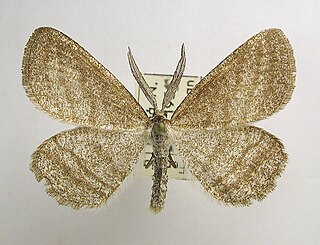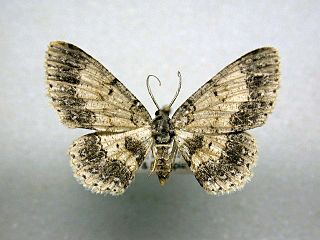
Perconia strigillaria, the grass wave, is a moth of the family Geometridae. The species was first described by Jacob Hübner in 1787. It can be found in Europe, east to the Urals, Asia Minor and China's Tarbagatai Mountains.
Physocleora is a genus of moths in the family Geometridae described by Warren in 1897.

Stenalcidia is a genus of moths in the family Geometridae.
Innovative companies rating «TechUspech» — a Russian economic rating of innovative companies, founded by Russian Venture Company, Foundation for Assistance to Small Innovative Enterprises in Science and Technology, the Foundation for infrastructure and educational programs RUSNANO and OJSC Russian Bank for Small and Medium Enterprises. Association of Innovative Regions of Russia is an operator of the rating.

Hemilophini is a tribe of longhorn beetles of the subfamily Lamiinae.
Alampyris is a genus of longhorn beetles of the subfamily Lamiinae, containing the following species:

New Jersey Amber, sometimes called Raritan amber, is amber found in the Raritan and Magothy Formations of the Central Atlantic (Eastern) coast of the United States. It is dated to the Late Cretaceous, Turonian age, based on pollen analysis of the host formations. It has been known since the 19th century, with several of the old clay-pit sites now producing many specimens for study. It has yielded a number of organism fossils, including fungi, plants, tardigrades, insects and feathers. The first identified Cretaceous age ant was described from a fossil found in New Jersey in 1966.
Alampyris curta is a species of beetle in the family Cerambycidae. It was described by Henry Walter Bates in 1881. It is known from Mexico.
Alampyris fuliginea is a species of beetle in the family Cerambycidae. It was described by Henry Walter Bates in 1881. It is known from Mexico.
Alampyris marginella is a species of beetle in the family Cerambycidae. It was described by Henry Walter Bates in 1881. It is known from Mexico.
Alampyris mimetica is a species of beetle in the family Cerambycidae. It was described by Henry Walter Bates in 1881. It is known from Mexico.
Alampyris nigra is a species of beetle in the family Cerambycidae. It was described by Henry Walter Bates in 1881. It is known from Mexico.
Alampyris photinoides is a species of beetle in the family Cerambycidae. It was described by Henry Walter Bates in 1881. It is known from Guatemala.
Alampyris quadricollis is a species of beetle in the family Cerambycidae. It was described by Henry Walter Bates in 1881. It is known from Mexico.
Alampyris flavicollis is a species of beetle in the family Cerambycidae. It was described by Galileo and Martins in 2005. It is known from Costa Rica.
Alampyris fusca is a species of beetle in the family Cerambycidae. It was described by Martins and Galileo in 2008. It is known from Costa Rica.
Alampyris melanophiloides is a species of beetle in the family Cerambycidae. It was described by Thomson in 1868. It is known from Mexico.
Eranina cretaria is a species of beetle in the family Cerambycidae. It was described by Galileo and Martins in 2005. It is known from Costa Rica.

Agraylea is a genus of microcaddisflies in the family Hydroptilidae. There are more than 20 described species in Agraylea.




